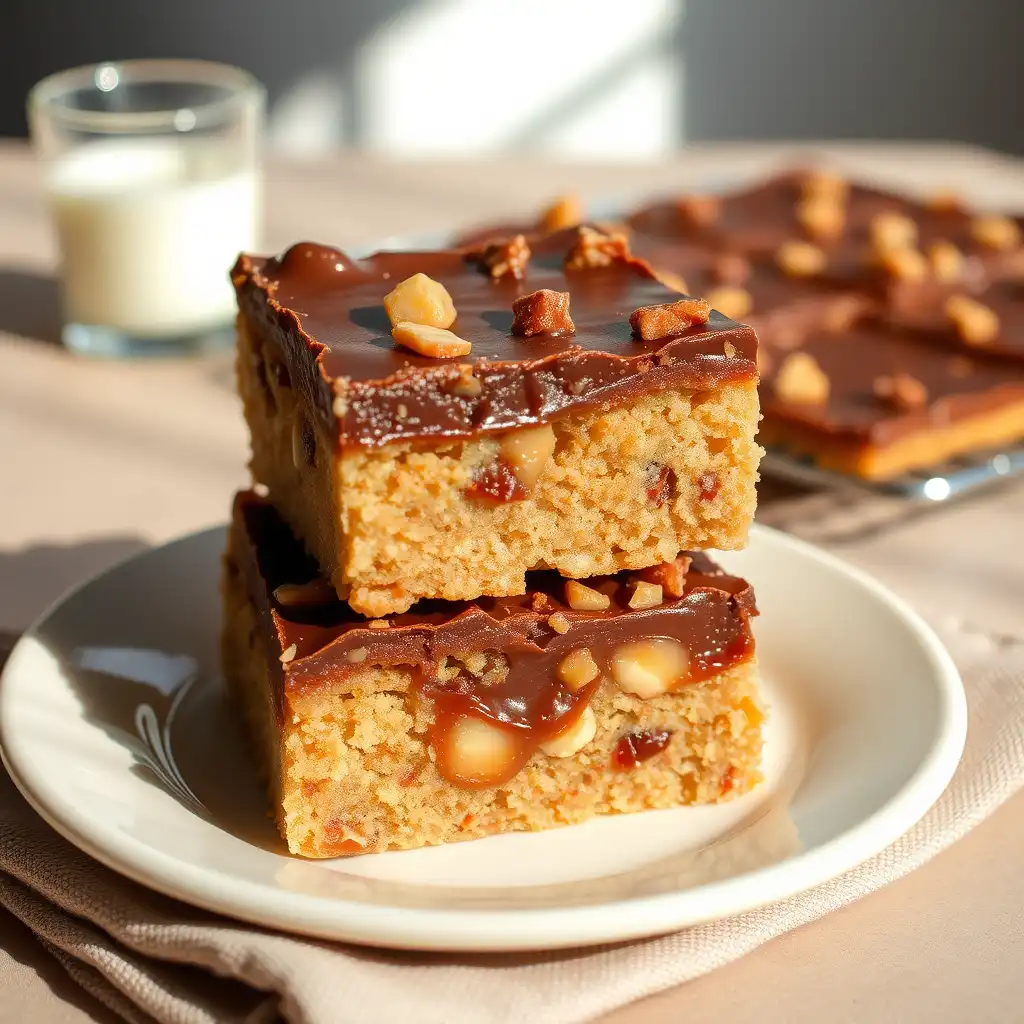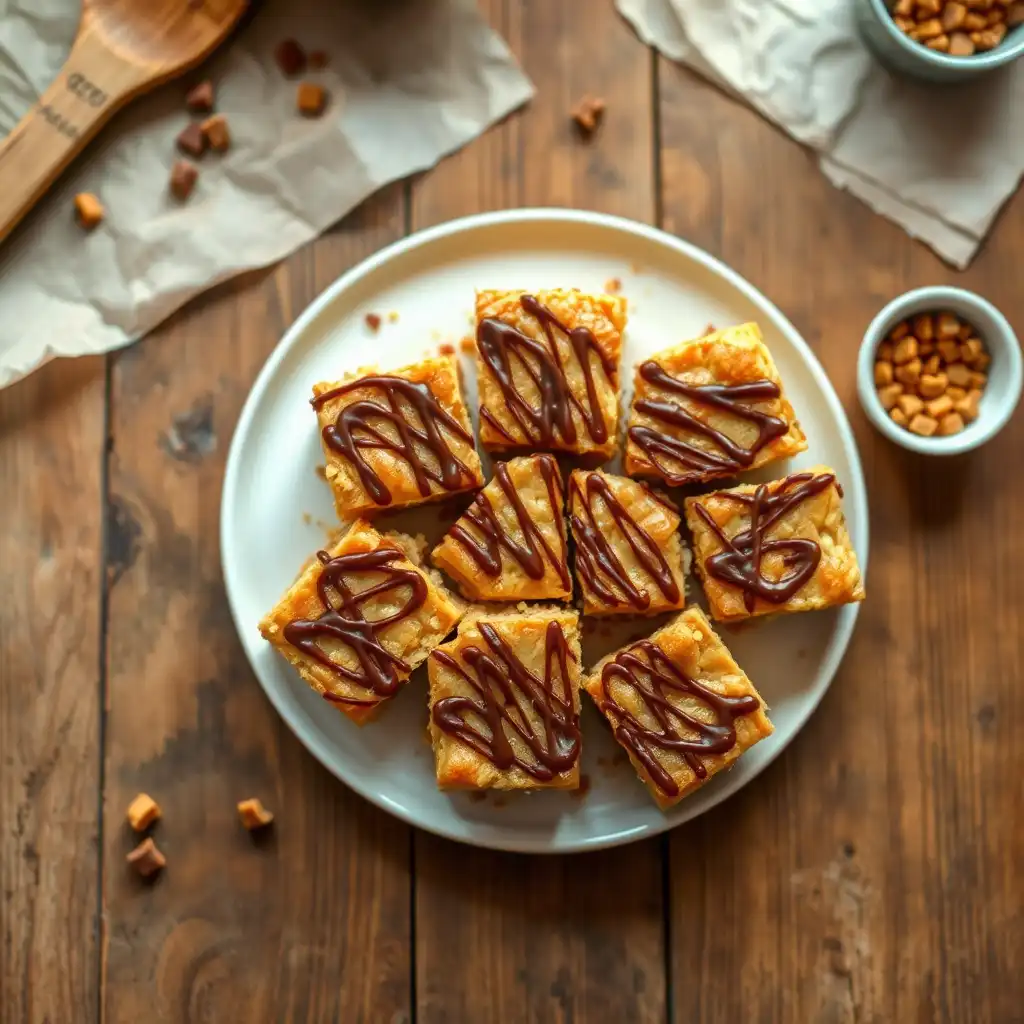Cake Mix Toffee Bars have a sneaky way of making you forget every other dessert on the table. I still remember the first time I bit into one at a community bake sale—soft, gooey, sweet, with this whisper of crunch that just snapped under my teeth. I had to know the recipe. And when the baker casually mentioned, “Oh, it’s just a cake mix,” my chef brain short-circuited. You mean this decadent, rich, layered treat came from a humble box mix? That moment turned me into a lifelong advocate for upgrading boxed cake mixes into bakery-level masterpieces.
Cake Mix Toffee Bars are a layered dessert built on the magic of convenience meeting culinary technique. You start with a cake mix base, layer in buttery richness, sprinkle in toffee bits, drizzle on chocolate, and let it all melt into a textural dream. It’s not fancy in the sense of soufflés or croquembouche—but oh, it is fancy in how it tastes. Sweet, salty, crunchy, chewy, all doing a little waltz in your mouth. Professionals love them because they’re quick yet endlessly customizable, and home bakers love them because they never fail to impress.
Cake Mix Toffee Bars also hold a sort of cultural charm. In America, recipes that start with a boxed mix have a nostalgic pull—mid-century cookbooks are full of them. But this is not a “dump everything and stir” kind of recipe. If you treat your ingredients with respect, pay attention to baking science, and tweak textures just right, these bars become something you’d be proud to plate in a patisserie.
Ingredients & Substitutions
Cake Mix Toffee Bars begin with a yellow cake mix. Choose a brand with a high butter content flavor profile—some cheaper mixes taste overly artificial, and that will haunt your final product. If you can find a butter-golden variety, even better.
Cake Mix Toffee Bars need butter. Real, unsalted butter, not margarine. You want that clean dairy fat to bind the crumbs without giving any waxy aftertaste. If salted butter is all you’ve got, reduce the added salt later in the recipe by half.
Cake Mix Toffee Bars require eggs for structure and moisture. Room-temperature eggs blend more evenly with the butter and mix, preventing clumps. If baking for someone with egg allergies, a flax egg can work in the base, though the texture will be denser.
Cake Mix Toffee Bars get their signature crunch from toffee bits. Use Heath or homemade bits for the best caramel flavor. Butterscotch chips can step in if toffee isn’t available, though the crunch factor will drop.
Cake Mix Toffee Bars shine with chocolate chips melted on top. Semi-sweet gives the right balance, but milk chocolate creates a softer, sweeter vibe. Dark chocolate will make the dessert taste a little more “grown-up,” almost bitter-sweet against the caramel tones.
Cake Mix Toffee Bars benefit from a pinch of flaky sea salt on top. It’s optional but elevates the entire flavor experience.

Step-by-Step Instructions
Cake Mix Toffee Bars start by preheating the oven to 350°F (175°C). Line a 9×13-inch pan with parchment—overhanging edges make lifting the bars easy later. Greasing the parchment is still wise; sugar loves to glue itself to surfaces.
Cake Mix Toffee Bars’ base is made by mixing the cake mix, melted butter, and one egg until crumbly. Do not overmix—this isn’t bread dough. Press two-thirds of the mixture firmly into the pan. Pressing too lightly will cause gaps; pressing too hard creates a dense, tough crust.
Cake Mix Toffee Bars gain their richness from sprinkling toffee bits over this base. Then scatter chocolate chips across. This layering ensures chocolate melts into the cracks, binding flavors together.
Cake Mix Toffee Bars get their second layer from the remaining dough. Crumble it unevenly over the top—little gaps let the chocolate peek through, creating that gorgeous marbled look after baking.
Cake Mix Toffee Bars bake for 25–30 minutes until edges turn golden. The center will still look slightly soft—this is key. Overbaking robs them of their gooey charm. Cool in the pan for at least 15 minutes before lifting out to slice. Cutting too soon will create a sticky mess (delicious, yes, but messy).
Cooking Techniques & Science
Cake Mix Toffee Bars rely on the Maillard reaction for flavor depth. The butter and sugars in the toffee caramelize, creating complex, nutty notes. That’s why baking just until golden is essential—you want enough browning without drying out the middle.
Cake Mix Toffee Bars’ texture contrast comes from fat control. Melted butter in the base coats flour particles, limiting gluten development. This keeps the crust tender rather than bread-like. Professionals know this is the same principle behind shortbread.
Cake Mix Toffee Bars benefit from controlled chocolate melting. Scatter chips on a hot base, and they’ll partially melt before the top layer is added. This creates little “pockets” of chocolate rather than a flat, uniform layer, which tastes more interesting bite to bite.
Cake Mix Toffee Bars’ cooling stage is not just for neat slicing. It lets the sugar crystals in the toffee re-harden slightly, giving you that subtle crunch that offsets the softness of the crumb. Skip the cooling, and you lose that magic.
Cake Mix Toffee Bars are also forgiving. Humidity slightly softens the toffee? Just bake two minutes longer. Cake mix brand too sweet? Balance with a dusting of cocoa powder in the dough. This adaptability is why pastry chefs keep recipes like this in their back pocket for last-minute catering gigs.
Serving & Pairing Suggestions
Cake Mix Toffee Bars are at their prime when slightly warm but not molten. This way, the chocolate is soft, the toffee crisp, and the base tender.
Cake Mix Toffee Bars pair beautifully with coffee—especially a bold, slightly bitter roast that cuts the sweetness. They also work with black tea or even a small glass of tawny port for dessert service.
Cake Mix Toffee Bars can be plated in elegant squares with a drizzle of warm caramel sauce and a sprinkle of crushed pecans for a restaurant-level dessert. Or, for a rustic feel, serve on a wooden board with fresh strawberries and whipped cream.
Cake Mix Toffee Bars also freeze well. Wrap tightly in plastic and freeze for up to 2 months. A quick warm-up in the oven brings them back to life for unexpected guests or late-night cravings.
Conclusion
Cake Mix Toffee Bars prove that great desserts aren’t always complicated. They balance nostalgia with culinary technique, yielding a dessert that feels both comforting and indulgent.
Cake Mix Toffee Bars also teach a valuable lesson to professionals and home cooks alike: technique often matters more than the ingredient list. You could hand someone the exact same ingredients and end up with wildly different results, depending on how they’re handled.
Cake Mix Toffee Bars remain one of those rare bakes that draw both seasoned pastry chefs and kitchen beginners to the same table. And really, isn’t that the mark of a recipe worth keeping?
FAQs
How do I keep my Cake Mix Toffee Bars from sticking to the pan?
Use parchment with overhang plus a light greasing. The sugar from the toffee can weld itself to unprotected pans.
Can I make Cake Mix Toffee Bars without eggs?
Yes—use flax eggs or commercial egg replacers. Expect a denser, slightly chewier texture.
What’s the best way to store Cake Mix Toffee Bars?
In an airtight container at room temperature for up to 4 days, or freeze individually wrapped bars for 2 months.
Can I use a chocolate cake mix instead of yellow?
Absolutely. It makes for a richer, brownie-like base, though it changes the flavor balance with the toffee.
Why is my base too hard?
You may have over-pressed the dough or baked too long. Next time, press just firmly enough to hold together and check doneness earlier.

Olivia P. is a seasoned food blogger at Tastywink, sharing delicious, easy-to-follow recipes inspired by him passion for home cooking. With years of culinary blogging experience, he brings flavor, creativity, and a personal touch to every dish.
